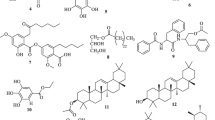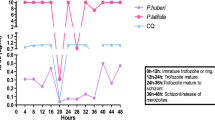Abstract
In order to prevent the destruction of the ecology and to sustain the flora mainly for medicinal plants, we investigated on alternative parts taken from four plants already known to display antiplasmodial activities and largely used by traditional healers in sub-Saharan Africa. The evaluated parts are bark of trunk for Zanthoxylum zanthoxyloides and leaves for Sarcocephalus latifolius instead of roots, and leaves for Combretum molle and Anogeissus leiocarpus instead of stem bark. The antiplasmodial activity of extracts of these plants was evaluated in vitro using the multi-resistant strain (W2) of Plasmodium falciparum. Antiproliferative activity was also assessed, using K562S human monocyte cell lines, along with calculation of the selectivity index (SI) of each extract. The highest in vitro antiplasmodial activity was found in the alkaloid extract of trunk bark from Z. zanthoxyloides and from the MeOH extract of A. leiocarpus leaves (IC50 = 1.2 µg/mL and 4.9 µg/mL, respectively) with good selectivity index. Moderate activity was found in the MeOH extract (IC50 = 5.7 µg/mL) and MeOH/H2O extract (IC50 = 7.9 µg/mL) of C. molle leaves. Moderate activity was also found in the MeOH/H20 extract (IC50 = 5.2 µg/mL) and the decoction (IC50 = 8.2 µg/mL) from leaves of A. leiocarpus. No good activity was found with extracts from roots of S. latifolius. All extracts tested displayed low levels of cytotoxicity against K562S cells. The data generated clearly show that the trunk bark for Z. zanthoxyloides and the leaves for A. leiocarpus and C. molle could be used for the treatment of malaria instead of roots and stem bark.
Similar content being viewed by others
References
Abreu P, Pereira A (2001) New indole alkaloids from Sarcocephalus latifolius. Nat Prod Lett 15(1):43–48
Asres K, Bucar F, Knauder E, Yardley V, Kendrick H et al (2001) In vitro antiprotozoal activity of extract and compounds from the stem bark of Combretum molle. Phytother Res 15(7):613–617
Azas N, Laurencin N, Delmas F, Di GC, Gasquet M et al (2002) Synergistic in vitro antimalarial activity of plant extracts used as traditional herbal remedies in Mali. Parasitol Res 88(2):165–171
Chaaib F, Queiroz E, Ndjoko K, Diallo D, Hostettmann K (2003) Antifungal and antioxidant compounds from the root bark of Fagara zanthoxyloides. Planta Med 63:319–320
Chandre F, Darrier F, Manga L, Akogbeto M, Faye O et al (1999) Status of pyrethroid resistance in Anopheles gambiae sensu lato. Bull World Health Organ 77(3):230–234
Deharo E, Bourdy G, Quenevo C, Munoz V, Ruiz G et al (2001) A search for natural bioactive compounds in Bolivia through a multidisciplinary approach. Part V. Evaluation of the antimalarial activity of plants used by the Tacana Indians. J Ethnopharmacol 77(1):91–98
Dhillion SS, Svarstad H, Amundsen C, Bugge HC (2002) Bioprospecting: effects on environment and development. Ambio 31(6):491–493
Diabate A, Baldet T, Chandre F, Guiguemde RT, Brengues C et al (2002) First report of the kdr mutation in Anopheles gambiae M form from Burkina Faso, West Africa. Parassitologia 44(3–4):157–158
Dieguez-Hurtado R, Garrido-Garrido G, Prieto-Gonzalez S, Iznaga Y, Gonzalez L et al (2003) Antifungal activity of some Cuban Zanthoxylum species. Fitoterapia 74(4):384–386
Fyhrquist P, Mwasumbi L, Haeggstrom CA, Vuorela H, Hiltunen R et al (2002) Ethnobotanical and antimicrobial investigation on some species of Terminalia and Combretum (Combretaceae) growing in Tanzania. J Ethnopharmacol 79(2):169–177
Gansané A, Nébié I, Soulama I, Tiono A, Diarra A et al (2009) Change of antimalarial first line treatment in Burkina Faso in 2005. Bull Soc Pathol Exot 102(1):31–35 French
Hadjeri M, Barbier M, Ronot X, Mariotte AM, Boumendjel A et al (2003) Modulation of P-glycoprotein-mediated multidrug resistance by flavonoid derivatives and analogues. J Med Chem 46(11):2125–2131
Hennenberg KJ, Minden V, Goetze D, Traoré D, Porembski S (2005) Size-class distribution of Anogeissus leiocarpus (Combretaceae) along forest-savanna ecotones in northern Ivory Coast. J Trop Ecol 21:273–281
Hounzangbe-Adote MS, Paolini V, Fouraste I, Moutairou K, Hoste H (2005) In vitro effects of four tropical plants on three life-cycle stages of the parasitic nematode, Haemonchus contortus. Res Vet Sci 78(2):155–160
Kassim OO, Loyevsky M, Elliott B, Geall A, Amonoo H et al (2005) Effects of root extracts of Fagara zanthoxyloides on the in vitro growth and stage distribution of Plasmodium falciparum. Antimicrob Agents Chemother 49(1):264–268
McGaw LJ, Rabe T, Sparg SG, Jager AK, Eloff JN et al (2001) An investigation on the biological activity of Combretum species. J Ethnopharmacol 75(1):45–50
Messmer WM, Tin-Wa M, Fong HH, Bevelle C, Farnsworth NR et al (1972) Fagaronine, a new tumor inhibitor isolated from Fagara zanthoxyloides Lam. (Rutaceae). J Pharm Sci 61(11):1858–1859
Ouattara A, Guissou P, Sawadogo A, Sawadogo M (1992) Etude comparative de la crise drépanocytaire chez les enfants de 5 à 15 ans à l'hôpital de Ouagadougou. Pharmacien d'Afrique 68:19–27
Rowe AK, Rowe SY, Snow RW, Korenromp EL, Schellenberg JR et al (2006) The burden of malaria mortality among African children in the year 2000. Int J Epidemiol 35(3):691–704
Shrestha PM, Dhillion SS (2003) Medicinal plant diversity and use in the highlands of Dolakha district, Nepal. J Ethnopharmacol 86(1):81–96
Shuaibu MN, Wuyep PA, Yanagi T, Hirayama K, Tanaka T et al (2008) The use of microfluorometric method for activity-guided isolation of antiplasmodial compound from plant extracts. Parasitol Res 102(6):1119–1127
Snow RW, Craig M, Deichmann U, Marsh K (1999) Estimating mortality, morbidity and disability due to malaria among Africa's non-pregnant population. Bull World Health Organ 77(8):624–640
Tabuti JR, Lye KA, Dhillion SS (2003) Traditional herbal drugs of Bulamogi, Uganda: plants, use and administration. J Ethnopharmacol 88(1):19–44
Trager W, Jensen JB (1976) Human malaria parasites in continuous culture. Science 193(4254):673–675
Traore A, Derme AI, Sanon S, Gansane A, Ouattara Y, Nebie I, Sirima SB (2009) Connaissances ethnobotaniques et pratiques phytothérapeutiques des tradipraticiens de santé de la Comoé pour le traitement du paludisme: processus d'une recherche scientifique de nouveaux antipaludiques au Burkina faso. Etnopharmacologia 43:35–46
Vonthron-Senecheau C, Weniger B, Ouattara M, Bi FT, Kamenan A et al (2003) In vitro antiplasmodial activity and cytotoxicity of ethnobotanically selected Ivorian plants. J Ethnopharmacol 87(2–3):221–225
Weill M, Fort P, Berthomieu A, Dubois MP, Pasteur N et al (2002) A novel acetylcholinesterase gene in mosquitoes codes for the insecticide target and is non-homologous to the ace gene in Drosophila. Proc Biol Sci 269(1504):2007–2016
WHO (1993) Global malaria control strategy. Bull Pan Am Health Organ 27(3):280–283
Acknowledgements
This work was supported by UNICEF/UNDP/World Bank/WHO Special Programme for Research and Training (TDR) Project ID No: A30930. We are grateful to the traditional health practitioners from the Province of Comoe, Western Burkina Faso, who participated in this study. We also thank the Faculty of Pharmacy, University of the Mediterranee, France and the administrative authorities of the province of Comoe for their support. Dr. Adama GANSANE is a PhD fellow supported by UNICEF/UNDP/World Bank/WHO Special Programme for Research and Training (TDR) Project ID No: 30838.
Ethical standards
The authors declare that the experiments comply with the current laws of the country in which they were performed.
Conflict of interest
The authors declare that they have no conflict of interests.
Author information
Authors and Affiliations
Corresponding author
Rights and permissions
About this article
Cite this article
Gansané, A., Sanon, S., Ouattara, L.P. et al. Antiplasmodial activity and toxicity of crude extracts from alternatives parts of plants widely used for the treatment of malaria in Burkina Faso: contribution for their preservation. Parasitol Res 106, 335–340 (2010). https://doi.org/10.1007/s00436-009-1663-y
Received:
Accepted:
Published:
Issue Date:
DOI: https://doi.org/10.1007/s00436-009-1663-y




